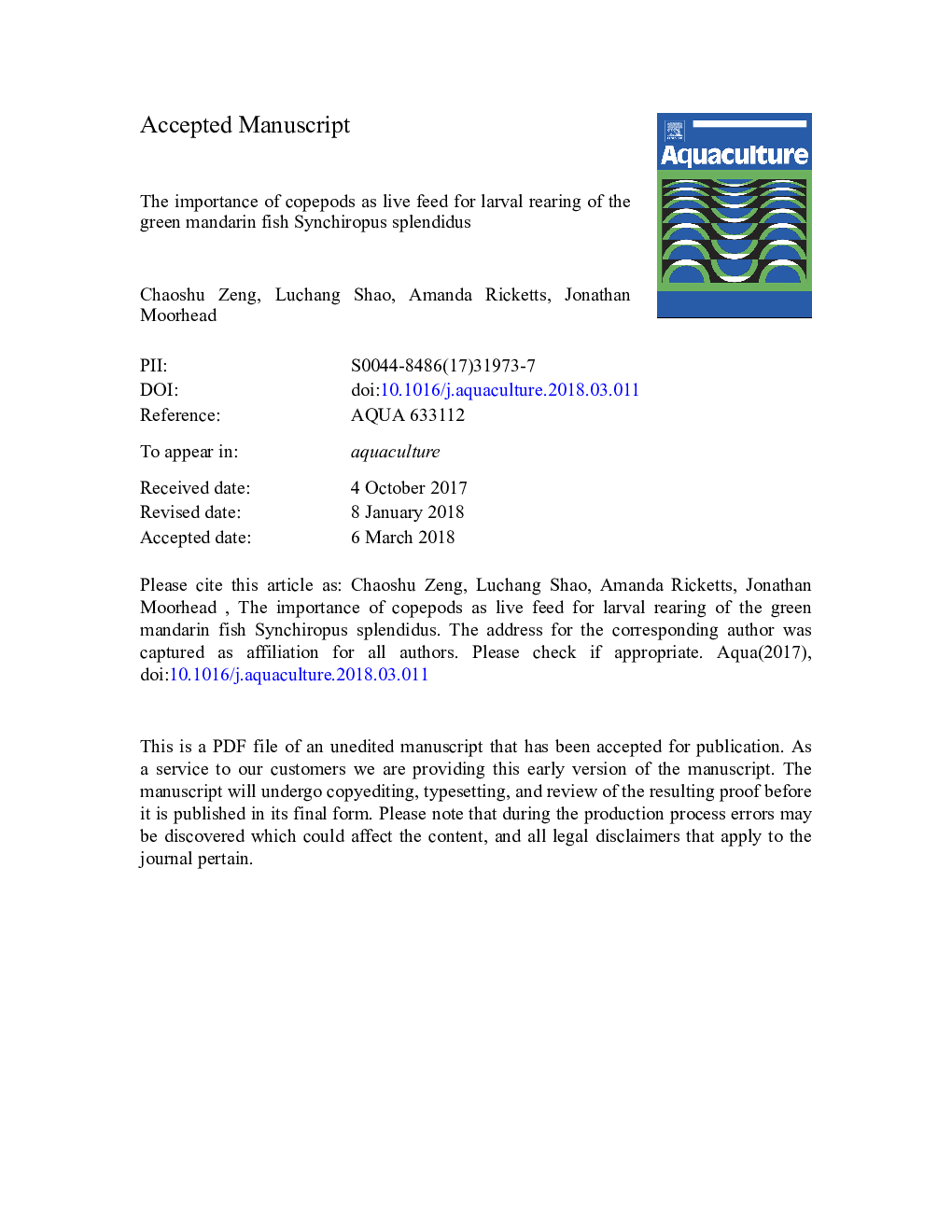| کد مقاله | کد نشریه | سال انتشار | مقاله انگلیسی | نسخه تمام متن |
|---|---|---|---|---|
| 8493264 | 1552797 | 2018 | 33 صفحه PDF | دانلود رایگان |
عنوان انگلیسی مقاله ISI
The importance of copepods as live feed for larval rearing of the green mandarin fish Synchiropus splendidus
دانلود مقاله + سفارش ترجمه
دانلود مقاله ISI انگلیسی
رایگان برای ایرانیان
کلمات کلیدی
موضوعات مرتبط
علوم زیستی و بیوفناوری
علوم کشاورزی و بیولوژیک
علوم آبزیان
پیش نمایش صفحه اول مقاله

چکیده انگلیسی
The green mandarin fish, Synchiropus splendidus, is a popular marine aquarium species, but currently sourced largely from the wild. To establish a reliable feeding regime for its larvae in captivity, a series of experiments were conducted. In the 1st experiment, newly hatched larvae were fed either unenriched rotifers (ss-type), rotifers enriched with Algamac 3000 or a mixture of commercial enrichments. An unfed control was also set up, which suffered a total mortality by 5â¯day post-hatching (DPH). All feeding treatments had similar low survival (<3.3%) by 11 DPH, suggesting rotifer enrichment bore little benefits. In the 2nd experiment, larvae were fed enriched and unenriched rotifers at 10â¯mLâ1 and a mixed diet of 2 copepods (nauplii and copepodites of Parvocalanus crassirostris)â¯+â¯8â¯rotifersâ¯mLâ1. The copepods co-feeding with rotifers treatment showed dramatically improved survival (50%) as compared to rotifer feeding only treatments (â¤5.6%) by 12 DPH (pâ¯<â¯0.01). The copepodsâ¯+â¯rotifers diet also generated significantly larger larvae (pâ¯<â¯0.01). The 3rd experiment aimed at determining the minimum quantity of copepods required for co-feeding with rotifers. Five treatments of copepods provided at 0, 0.1, 0.5, 1.0 and 2.0â¯mLâ1 with rotifers making up the rest of a total of 10â¯preyâ¯mLâ1 were set up. Larval survival to 11 DPH were significantly higher in the 2 copepodsâ¯+â¯8â¯rotifersâ¯mLâ1 and 1 copepodsâ¯+â¯9â¯rotifersâ¯mLâ1 treatments (52% and 48%) than other treatments (<19%) while no significant difference was detected between the two treatments. Larval growth was not significantly different among all copepod feeding treatments, even copepods were provided at only 0.1â¯mLâ1, and they were all significantly higher than the rotifer feeding only treatment (pâ¯<â¯0.05). Our results demonstrated the importance of copepods as prey for rearing early larval S. splendidus and suggested that they should be co-fed at least 1.0â¯mLâ1 to ensure good survival.
ناشر
Database: Elsevier - ScienceDirect (ساینس دایرکت)
Journal: Aquaculture - Volume 491, 1 April 2018, Pages 65-71
Journal: Aquaculture - Volume 491, 1 April 2018, Pages 65-71
نویسندگان
Chaoshu Zeng, Luchang Shao, Amanda Ricketts, Jonathan Moorhead,